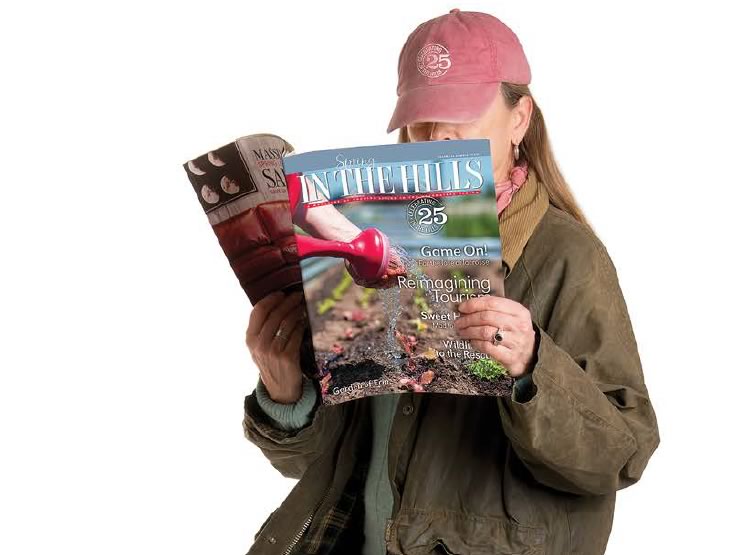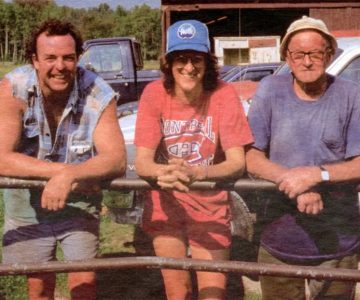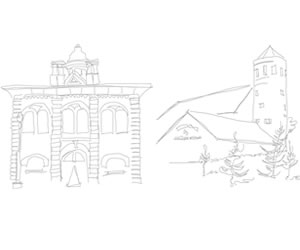A Quarter Century – and Counting
Every column and feature in the magazine passes through this filter: What does it tell us about the place we call home and the people who live here?
Well, that went fast – the last quarter century and all. With this issue In The Hills launches its 25th year, or volume as we say in the trade. Come winter, we’ll publish issue 100.
In many ways issue 1, that first 24-page magazine in 1994, feels little more than a heartbeat ago. At least it does until you pull it from the dusty depths of the archives and realize how much has changed since then, in the industry and in the community.

Last fall, a reader requested a back copy featuring a profile of Caledon dairy farmer Art Bracken. The story ran in autumn 1995 (we’d grown to 32 pages!) Of course, we were happy to supply it (reducing our remaining copies of that issue to five), but I felt obliged to warn the reader the magazine she would receive was a far cry from the magazine as she now knows it.
For one thing, it was printed on newsprint. We didn’t make the switch to coated stock until 2002 – a move that dismayed some of our readers who were fond of the homey look, but pleased our advertisers and photographers. The issue also reflected the production constraints of those labour-intensive, pre-digital-publishing days. We were still waxing some of our ads onto paper flats. Sections were printed in either black, with spot colour or, most expensively, four-colour, requiring some fancy layout maneuvers so the limited number of colour pages would fall where we wanted them. We now upload our full-colour digital files to the printer, direct to plate, in a matter of a few minutes.
There was only one colour ad in that 1995 issue (Granny Taught Us How) and two ads in spot colour. All the rest were black and white. And there were only two half-page ads – Granny again and Bryan’s Fuel, both of whom came on board in year one and are still with us. (We like to think, gratefully, that’s because those two enduring and exceptionally successful local businesses know a thing or two about advertising.)
But it’s not just the production process that has changed since then. The story about farmer Art Bracken is a reminder the magazine launched as the community here was in the midst of dramatic transition.
I well remember setting my alarm for 4 a.m. to be at Art’s large wooden barn in time for the morning milking. Since moving to Caledon in 1974, I had always been enchanted by his Glen-Caro farm with its no-nonsense brick farmhouse, built by his grandfather and perched on a slight knoll in the middle of the open farm fields on maple-lined Grange Sideroad (still Five Sideroad then). On occasion I’d had to stop my car and been charmed to wait as Art drove his herd of pretty, doe-eyed Jerseys across the road to his south field.
But the interview that morning was a sobering one. In his 80s, Art was profoundly aware he represented a way of life that had all but disappeared. “I’ve seen a lot of changes here,” he told me. With the farm now surrounded by country estates, he said, “I don’t have any neighbours anymore,” then corrected himself: “Oh, I have neighbours. A lot of nice people, good people. But they’re a different generation. They have a different lifestyle. They’re not farmers. I’m the only farmer left here now – except for Jim Petch over on the First Line.” Of Jim, he added, “We’re half lonely now. We don’t have many people drop by to visit anymore.”
My visit to Art had been motivated by romance and nostalgia, and a desire to document a way of life that was passing – all those things that had drawn me to live here in the first place. Our circulation in 1994 was to 24,000 households in Caledon, Dufferin and Erin. Today our distribution has nearly doubled to more than 40,000 households – an increase directly proportional to the region’s population growth. There’s no denying that growth, along with the many new service and retail businesses accompanying it, has been good for our business. But that hasn’t stopped us from frequently editorializing on the need to manage and limit growth in order for life here to evolve in ways that won’t destroy the best of what our countryside has to offer. In this issue, writer Liz Beatty again raises the call, this time from the perspective of the role tourism could – Liz argues should – play in that evolution.
Every column and feature in the magazine passes through this filter: What does it tell us about the place we call home and the people who live here? We hope our readers will find plenty to amuse, charm and inform them about local arts, heritage, nature, entertainment and enterprise, but we also believe that Liz’s story on reimagining tourism is an example of the best the magazine and its exceptional contributors strive for – a thoughtful perspective on issues that affect who we are and how we define ourselves. Our aim is to examine local concerns in a wider context or, conversely, review the impact of broader policies and trends on our daily lives here. That goal is one thing that has remained constant since the magazine’s inception.
Art Bracken died in 2009 at age 96. One is tempted to say that with his passing the mold of the old-style farmer was broken. But there have been other sea changes in the hills since then, changes neither Art nor I would have predicted as the sun rose on that distant summer day – although Art’s farmhand Deb Kendall might have been a clue.
In her mid-30s at the time of my visit, Deb had grown up on a local dairy farm and – a rarity among her childhood chums in the 4H Club, even more so among the girls – she was determined to make farming her career. Two decades on, she is no longer alone.
The emergence of a new generation of young, mostly small-scale farmers in this region is just one of the evolutions that has been well documented in these pages over the years – though “old-style” is not the term to describe these savvy, hardworking and entrepreneurial farmers who have jumped on the demand for local food and are once again redefining our community culture. And as we go forward, it is to that new generation and their peers across the spectrum of endeavour that we turn much of our attention.
The lead feature in our inaugural issue was about two exciting organizations which also launched in 1994 – Theatre Orangeville and Dufferin County Museum & Archives. Five years ago the three of us celebrated our 20th anniversary together under the tagline “Our History, Our Drama, Our Stories.” This year, while we will each no doubt do our share of looking back, together our main focus will be on looking forward.
There are in this community young people who have never known a time when the theatre did not anchor Broadway, the big green barn of a museum did not stand sentinel on a hill overlooking the countryside, and In The Hills did not arrive in the mailbox four times a year. It is these young people we want to celebrate this year with our 25 Under 25 awards, planned to be unveiled this fall. In the coming months we will be seeking nominations of youths and young adults who have already displayed the skill, passion and commitment that will shape this community and beyond in the next quarter century.
Please stay tuned.
Related Stories

A Dairy Farmer’s Tale
Sep 15, 1995 | | FarmingHis Jersey cows have provided Art Bracken with a good life. And as the community changes around him, the daily routines on his Caledon farm remain the same.

David & Wayne’s Excellent Adventures
Jun 17, 2013 | | Back IssuesFor museum curator Wayne Townsend and Theatre Orangeville artistic director David Nairn, it’s been an exhilarating ride.

Drama and History
Jun 17, 2013 | | Editor’s DeskIf for some crazy reason, you have not been to a performance at Theatre Orangeville, or not explored the rich local history at the museum, you’re missing out on two of our most exceptional local treasures!








